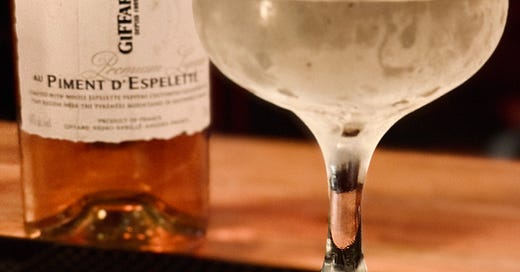Salt and Pepper Your Martini
A sophisticated Martini riff from a classy New York bar, and an easy homemade alternative.
I’ve had a lot of fun using Substack’s live video feature to demonstrate making drinks these last two weeks—and it seems like a lot of you have too. The response has been strong enough that I’m going to try to keep it up at least semi-regularly, whenever my sometimes hectic schedule allows. This week, we’re going try a weeknight show.
Starting around 7 p.m. ET, on Tuesday, April 22, I’m going to go live. I’ll make a Martini of some variety, and talk about the Martini as a cocktail format. Join me on the Substack app to share a drink, ask questions, demand I explain my ice choices, and perhaps catch a guest appearance from a large dog or two.
Links About Drinks
We’re drinking Martinis (and Not Martinis) in the newsletter all month, and it seems like everyone else is too. There are new Martini-focused bars popping up everywhere. A couple that recently caught my eye: Slim Charmer, in St. Petersburg, Florida, is a tiny spot that boasts a 10-Martini menu. Here in Washington, D.C., there’s Bar Angie, which promises “free-flowing icy Martinis” including “a dirty Martini served with blue cheese olives, plus a sidecar of extra Martini and garnishes ‘to keep the party going.’” It’s $40, so it better. (For about that price, you could also keep the party going with at-home Martinis for an entire group of friends.)
It must be Martini season: Punch performed some data journalism on Martinis served at New York bars. A few bits that stood out: There’s an even split between vodka and gin, which wouldn’t have been true even 15 years ago, when vodka Martinis ruled; Martini mania does seem to be fading slightly, at least in New York, with scene-y spot Bemelmans serving “only” 800-900 Martinis a night, compared with 1,000 a few years ago. Also, Punch reports that Bemelmans “noted an uptick in Scotch Martinis.” Er, what?
What cocktail technique is most overrated? A surprising number of bartenders seem to think the answer is the “dry shake,” the initial, no-ice shake sometimes called for in drinks that use egg or egg whites.
Girl Scout cookie-themed cocktails? Predictably, the Thin Mint is a “a fun, modern take on the grasshopper.” I wonder what David Embury would think.
The annual list of North America’s 50 Best Bars is now a list of North America’s 100 best bars, sort of. The highly regarded annual bar ranking released its first ever 51-100 list this week, a sort of runners-up list that recognizes the increasing number of excellent cocktail bars across the continent. The New York-heavy list included a number of stalwarts of the early cocktail renaissance, including Attaboy (#66) and The Dead Rabbit (#57). The top 50 will be announced later this month.
(s)Alt Rock
In last week’s newsletter, I argued that the Dirty Martini was misunderstood. Yes, it’s often made carelessly, and the name gives the drink a certain connotation that turns off some people. But properly understood, it’s really just a Salted Olive Martini—a briny, vegetal riff on the drink that takes the Martini in a savory direction.
This week I want to take a look at another salty Martini. I first encountered this drink at New York’s Temple Bar, a dark and swanky cocktail den that reopened a few years ago. Temple Bar doesn’t get quite as much press or awards as some of the city’s bars but it serves excellent drinks.
The bar’s most famous drink is probably its Blue Negroni, a wink-wink, self-aware entry into the Blue Drink Discourse that uses a housemade, aqua-colored Campari substitute to achieve a bright blue color in a drink that mostly just tastes like a conventionally well-made Negroni.
But at heart, Temple is a moody Martini bar, with a long list of Martinis and Martini-esque concoctions for those times when you want a drink that is almost but not quite a Martini.
One of those not quite Martinis is their Salt and Pepper Martini, which combines a unique pepper liqueur, celery bitters, and briny dry sherry.
This is the sort of cocktail that most home bartenders probably won’t make at home—not because it’s particularly challenging to execute, but because of the intimidating ingredient list, which definitely goes beyond what you’re likely to find on even the most well-stocked home bar carts. I have hundreds of bottles and a particular interest in strange liqueurs, and even I had to purchase one of the required bottles specifically to make this drink.
Yet this sort of cocktail is worth breaking down and understanding even if you never plan to make it yourself—partly because looking under the hood can help show you how pros use simple cocktail formats as platforms for more complex ideas, and partly because understanding this sort of drink can sometimes inspire other cocktails that you can make at home. Which is exactly what happened to me.
So this week, we’re going to look at Temple Bar’s recipe—which I do encourage you to make if you have the ingredients!—and then we are going to make a dead-simple, no-fancy-ingredients Martini inspired by it. It’s a two-Martini week.
Veruca Salt
Let’s start by going directly to Temple Bar’s recipe, and examining each ingredient and its role and function in the drink.



